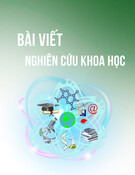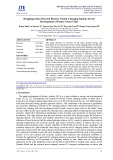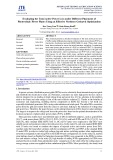
16
TẠP CHÍ KHOA HỌC VÀ CÔNG NGHỆ NĂNG LƯỢNG - TRƯỜNG ĐẠI HỌC ĐIỆN LỰC
(ISSN: 1859 - 4557)
POLICY PROPOSED FOR RENEWAL ENERGY MARKET IN VIETNAM BASED ON EPM MODEL
ĐỀ XUẤT CHÍNH SÁCH CHO THỊ TRƯỜNG NĂNG LƯỢNG TÁI TẠO TẠI VIỆT NAM DỰA TRÊN MÔ HÌNH EPM
Nguyen Thuy Ninh
(1)
, Chu Van Tuan
(1)
, Duong Chau Sam
(2)(1)
Electric Power University,
(2)
Thanh Dong University Ngày nhận bài: 02/05/2024, Ngày chấp nhận đăng: 27/06/2024, Phản biện: PGS.TS. Đỗ Anh Tuấn
Abstract:Vietnam is a developing country with a high growth rate, so the demand for energy increases with the amount of greenhouse gas emissions. To realize the dual goal of ensuring a parallel growth rate with the decarbonization of the economy, Vietnam has been accelerating the transition to energy balance with all resources, while enhancing cooperation and support from development partners. According to Vietnam’s Eighth National Power Development Plan, the goal is to gradually reduce electricity using fossil fuels, giving priority to the development of renewable energy, new and clean energy. The development of mechanisms and policies for renewable energy development must be built continuously and in the long term, ensuring a fair energy transition, and meeting the country’s sustainable development requirements. However, at present, there is still no comprehensive approach to support strategic planners to develop specic policies and mechanisms to promote renewable energy through the interaction of members, towards the electricity market innovation ecosystem and ancillary services. This article analyzes the structure of Vietnam’s electricity market, and its relationships, how members interact with each other, proposing policies for the renewable energy market in Vietnam and by Ecosystem Pie Model (EPM). Keywords: Policy, renewable energy, Ecosystem Pie Model (EPM), visual strategy tool, innovation ecosystem, electricity market.Tóm tắt: Việt Nam là quốc gia đang phát triển với tốc độ tăng trưởng cao, do đó nhu cầu năng lượng ngày càng tăng cùng với lượng phát thải khí nhà kính. Để hiện thực hóa mục tiêu kép vừa đảm bảo tốc độ tăng trưởng song song với quá trình phi cacbon hóa nền kinh tế, Việt Nam đã và đang đẩy nhanh quá trình chuyển dịch cơ cấu năng lượng theo hướng cân đối mọi nguồn lực, đồng thời tăng cường hợp tác và hỗ trợ từ các đối tác phát triển. Theo Quy hoạch phát triển điện lực quốc gia lần thứ VIII của Việt Nam, mục tiêu là từng bước giảm điện than, ưu tiên phát triển năng lượng tái tạo, năng lượng mới, năng lượng sạch. Việc xây dựng cơ chế, chính sách phát triển năng lượng tái tạo cần được xây dựng liên tục và dài hạn, đảm bảo quá trình chuyển đổi năng lượng công bằng, đáp ứng yêu cầu phát triển bền vững của đất nước. Tuy nhiên, hiện nay vẫn chưa có một cách tiếp cận toàn diện hỗ trợ các nhà hoạch định chính sách chiến lược xây dựng các chính sách, cơ chế cụ thể thúc đẩy năng lượng tái tạo thông qua sự tương tác của các thành phần trong hệ thống năng lượng, hướng tới hệ sinh thái đổi mới thị trường điện và dịch vụ phụ trợ. Bài báo phân tích cấu trúc thị trường điện Việt Nam, mối quan hệ và sự tương tác giữa các thành phần, từ đó ứng dụng mô hình hệ sinh thái (EPM) đề xuất các chính sách cho thị trường năng lượng tái tạo tại Việt Nam.Từ khóa: Chính sách, năng lượng tái tạo, Mô hình hệ sinh thái (EPM), công cụ chiến lược trực quan, hệ sinh thái đổi mới, thị trường điện.

17
TẠP CHÍ KHOA HỌC VÀ CÔNG NGHỆ NĂNG LƯỢNG - TRƯỜNG ĐẠI HỌC ĐIỆN LỰC
(ISSN: 1859 - 4557)
1. INTRODUCTION Vietnam’sEighthNationalPowerDevelopmentPlan
(PDP VIII) sets out key goals. The rst goal is to
rmlyensurenationalenergysecurity,andtomeet
the requirements of socio-economic development
industrialization, andmodernizationofthecountry.
The second goal is to successfully implement a
fair energy transition associated with modernizing
production, building a smart grid, and advanced
powersystemmanagement,inlinewiththetrendof
greentransitionandemissionreductionandenergy
production,scienticandtechnologicaldevelopment
of the world. To achieve this central goal, the
electricitymarketandancillaryservicesneedtoform
an integrated innovation ecosystem, promoting the
development ofrenewable energy and new energy
[1]. In particular, the development of mechanisms
and policies for renewable energy development
needstobebuiltcontinuouslyandinthelongterm,
ensuring a fair energy transition, and meeting the
country’ssustainabledevelopmentrequirements.
Therelationshipandinteractionbetweenmembers
arearrangedintoavisualstrategytoolcalledthe
EcosystemPieModel(EPM)fromwhichtobuild
an overall picture and propose policies for the
renewableenergymarketinVietnam.
2. INNOVATION ECOSYSTEM AND VISUAL STRATEGY TOOL ECOSYSTEM PIE MODEL (EPM)Intheinnovationecosystem,itisnecessarytond
thepillarcomponents,thenputalltheseactorsinto
acirculardiagramcalledtheEcosystemPieModel
(EPM). To nd motivating policies, we need to
analyze building blocks at the ecosystem level;
andbuildingblocksattheagentlevel;thenanalyze
the relationships between actors, observing how
actorsinteract[2].
There are dierent views on the innovation
ecosystem.AccordingtoAdner(2017),aninnova
tionecosystemisanetworkoforganizationswhose
(innovative) products or services come together
to achieve overall value (of the ecosystem).Any
innovationecosystemdependsontheattributesof
individual actors, as well as the properties of the
ecosystem network. Therefore, when designing,
it is necessary to correctly identify building
components at the ecosystem level and the actor
level.
2.1. Building blocks at the ecosystem level [2]
(1)Actors:Thepillarswilldependoneachother,
providing certain complementary services and
forming an interconnected network, which when
interactingwitheachotherwillcreatevalueforthe
enduser.WhensortedintotheEPM,eachactoris
representedbyanareaofthe‘ecosystempie’andis
arrangedclockwisetorepresenttheareabetween
these actors. These actors form a value chain in
whichthenextactortakestheproduct/serviceof
thepreviousactorasinputandproducesanoutput
thatcombinesseveralvalue-addedelementsfrom
thatactor.
(2) The overall value of the ecosystem: is the
aggregateoutputoftheentireecosystemtowards
theenduser.ThisisthecenterofEPM.Allactors
are arranged around, participating directly or
indirectly contributing to value creation towards
overallvalue.
(3) User segmentation: one of the important
actorsparticipatinginthevaluecreationprocess,
arranged in a separate area in EPM, is the user.
Userscanparticipateearlyintheproduct/service
developmentprocess,providingregularfeedback
toformthebasisforproduct/servicedevelopment
throughtheirownexperiences.

18
TẠP CHÍ KHOA HỌC VÀ CÔNG NGHỆ NĂNG LƯỢNG - TRƯỜNG ĐẠI HỌC ĐIỆN LỰC
(ISSN: 1859 - 4557)
With additional functionality, users promote the
introductionandexpansionofthemarketfornew
potential users, contributing to improving the
qualityoftheecosystem.
2.2. Building block in agent level [2]
Ineachactor,theoverallpictureshouldconsider
thatactor’svalue-addedfactororresourcefactor.
(4) Value added:Actors participate as producers
(possibly possessing a comparative advantage
over other actors). The combination of actors
throughcomplementaryservicesaimstoachieve
overallvalue.
(5)Resources:theimportantfactorthatcreatesthe
foundationforthevaluecreationofaspecicactor
isresources.Resourcesincludealltypesoftangible
and intangible assets, capabilities, organizational
processes,attributes,information,andknowledge
aboutthebusinessavailabletoactorsto perform
value-creatingactivities.
(6)Activities:Inthebuildingblock,activitiesare
the mechanisms by which actors use available
resourcesandcontributetotheecosystem.
Thus,activitiesoftencrosstheactor’sboundaries
andcombinewiththeactivitiesofotheractorsto
createavalue-addedchain.ThroughtheEPMmap,
activitiesandinteractionsareseenmoreclearly.
(7) Captured value: For an actor, the higher the
resources, activities, and added value factors
contributing to the ecosystem, the higher the
ability to capture the expected value.This value
canbenancialornon-nancial.Whenassessing
relevance, the opportunity to capturevalue must
becomparedwiththecosts(includingopportunity
costs) associated with realizing that value.
Therefore, for potential (not yet operational)
ecosystems, the value capture may include
informationalvalueinconditionalform,reecting
theactor’sminimumexpectations.
(8) Dependency: An ecosystem is a synthetic
networkofdependentandinteractiverelationships
including many dierent actors measured at
three levels: L - low level of dependence, M
- medium level of dependence, and H - high
degree of dependence. This respective level of
dependenceismarkedonthefactordivideronthe
correspondingcircle.
(9)Risk:Intheory,whendesigningtheEPMmap,
weneedtoassumethewillingnessandabilityofthe
subjectstocontribute.Tocomeupwithastrategyfor
developingtheecosystemintheshort,medium,and
longterm,weneedtoevaluateandforecastthelevel
ofrisk.Therefore,agentsneedtoberepresentedas
low,medium,andhighriskonthemap.
3. MODEL STRUCTURE OF VIETNAM’S ELECTRICITY MARKET AND THE TREND OF ENERGY BALANCE TRANSITION
3.1. Abbreviations Structure of Vietnam’s Electricity Market
The original structure of Vietnam’s electricity
market was a vertically linked monopoly power
marketmodel.ACompanyorGroup(usuallythe
Government) owns all power generation plants,
transmissionsystems,electricitydistribution,and
retailunits,holdsthecontrolfunction,andoperates
the power system. Electricity consumers in an
area can only buy electricity from an electricity
distributorandretailer[1].However,currently,the
electricity markets in countriesaround the world
and inVietnam have developedinto competitive
electricity market models, of which the popular
model is the competitive wholesale electricity
market and a more complete model. It is a
competitiveretailelectricitymarket.

19
TẠP CHÍ KHOA HỌC VÀ CÔNG NGHỆ NĂNG LƯỢNG - TRƯỜNG ĐẠI HỌC ĐIỆN LỰC
(ISSN: 1859 - 4557)
Table 1, Vietnam’s Electricity Market Development Roadmap
Level 1 Level 2 Level 3
Generation
Market
(VCGM)
Wholesale
Electricity
Market
(VWEM)
Competitive
RetailMarket
(VREM)
Pilot:
2011-2012
Pilot:
2016-2018
Pilot:
2021-2023
Ocial:2012-
2018
Ocial:
from2019
Ocial:
from2023
Figure 1. Competitive retail market3.2. Power Development Plan VIII and Energy Balance Shifting Trend
At COP 26, Vietnam committed to reducing net
emissionstozero by2050.To achieve this goal,
theGovernmentofVietnamhasproactivelymade
eorts to implement and set plans for the short,
medium,andlongterm.Inparticular,itfocuseson
developingrenewableenergyeldssuchaswind
and solar energy, protectingforestsand reducing
methane, and converting from fossil energy to
fossilenergy,fuelforcleanenergy[3].
Regarding the scale of the power system: The
totalpowercapacityoftheentiresystemreaches
about77,800MW,anincreaseofabout1,400MW
comparedto2021,accordingtothereportatthe
end of 2022. Vietnam Electricity Group (EVN)
holds29,901MW(includingdirectandindirect)-
accountingfor38.4%ofthetotalsystemcapacity.
The total capacity of renewable energy sources
including wind power and solar power is about
20,165MW-accountingfor26.4%,coalthermal
poweris25,312MW-accountingfor32.5%,and
gasthermalpoweris9.2%respectively.With7,160
MW, hydropower (including small hydropower)
is22,544MW-accountingfor29.0%.Withthis
capacity, Vietnam’s power system is among the
topintheASEANregion.
Figure2shows thepowerstructureofthewhole
systembytheendof2022.
Figure 2. The power structure of the whole system by the end of 2022
Regardingelectricityproductionandsupply:
- The electricity output produced and imported
throughout Vietnam’s electricity system in 2022
isabout268.4billionkWh,anincreaseof5.26%
comparedto2021.Themaximumloadcapacityof
theentiresystemin2022is45,434MW,anincrease
of4.41%equivalentto 43,518MWcomparedto
2021(DatacalculatedonJune21,2022).
- In 2022, the electricity output produced and
purchased by Vietnam Electricity Group will be
about 261.2 billion kWh, an increase of 6.08%
comparedto2021,ofwhichelectricitypurchased
fromsourcesoutsidetheElectricityGroupis139.4
billion kWh, an increase of 13.6% compared to
2021(53.4%).
-Tomeettheforecastgrowthrequirementofabout
7%/year in the period 2021-2030, and about 6.5

20
TẠP CHÍ KHOA HỌC VÀ CÔNG NGHỆ NĂNG LƯỢNG - TRƯỜNG ĐẠI HỌC ĐIỆN LỰC
(ISSN: 1859 - 4557)
to7.5%/yearintheperiod2031-2050,thePower
DevelopmentPlanneedstodevelopastrategyand
development roadmap. Specically, sustainably,
ensuring national energy security during these
periods.
Accordingly, Vietnam’s Eighth National Power
DevelopmentPlanprioritizesstrongdevelopment,
bringing electricity produced from renewable
energy sources into the grid, meeting the
requirementsofsocio-economicdevelopmentand
global trends. This power source is estimated to
reach a rate of about 30.9 - 39.2% by 2030. By
2050,therateofrenewableenergyisexpectedto
reach67.5-71.5%[1].
4. ANALYSIS OF ELECTRICITY MARKET COMPONENTS VIA EPM VISUALIZATION TOOL Competitive retail electricity market model: The
ecosystem-levelbuildingblockconsistsofactors
clockwise from certiers/public institutions to
producers, and wholesalers, from consulting and
networkoperatorstoretailersandusersegments.
Theentireecosystemistowardstheoverallvalueof
thecompetitive,open,andtransparentrenewable
energymarket[4].Electricitymarketstructureand
relationshipsinEPMareshowninFigure3.
Current renewable energy development policies
include:
- Building a competitive electricity market step
bystepandactively.Upgradingthetransmission
systemtointegraterenewableenergy.
- Commitment to clean energy strengthens its
position in Vietnam’s attractive FDI market.
Strengthendisputeresolutiontoimproveinvestor
condence.
-Creatingalevelplayingeldbetweenpublicand
privateinvestors(IPPandEVN),anddomesticand
foreign investors. Building a transparent bidding
process,andaspecicroadmap.
-Enhancetheindependenceofmarketparticipants
toensureeectivecompetition.Facilitatingaccess
tolandforrenewableenergydevelopment[5].
By creating links between actors, the analytical
model shows that current policies are largely
focused on creating a legal corridor, promoting
Figure 3. Electricity market structure and relationships in EPM












![Trắc nghiệm Mạch điện: Tổng hợp câu hỏi và bài tập [năm hiện tại]](https://cdn.tailieu.vn/images/document/thumbnail/2025/20251118/trungkiendt9/135x160/61371763448593.jpg)













